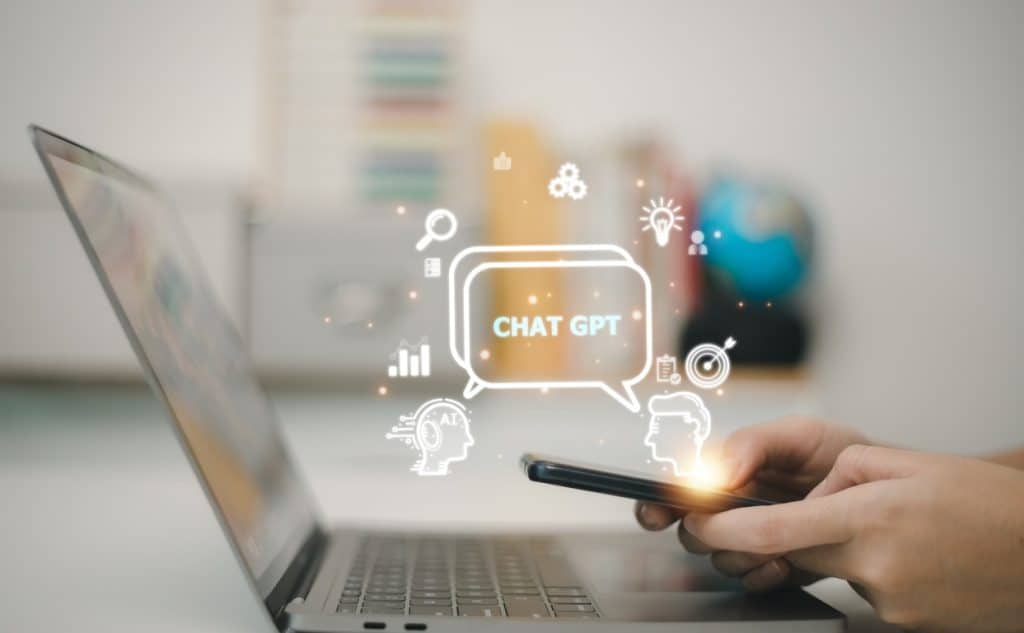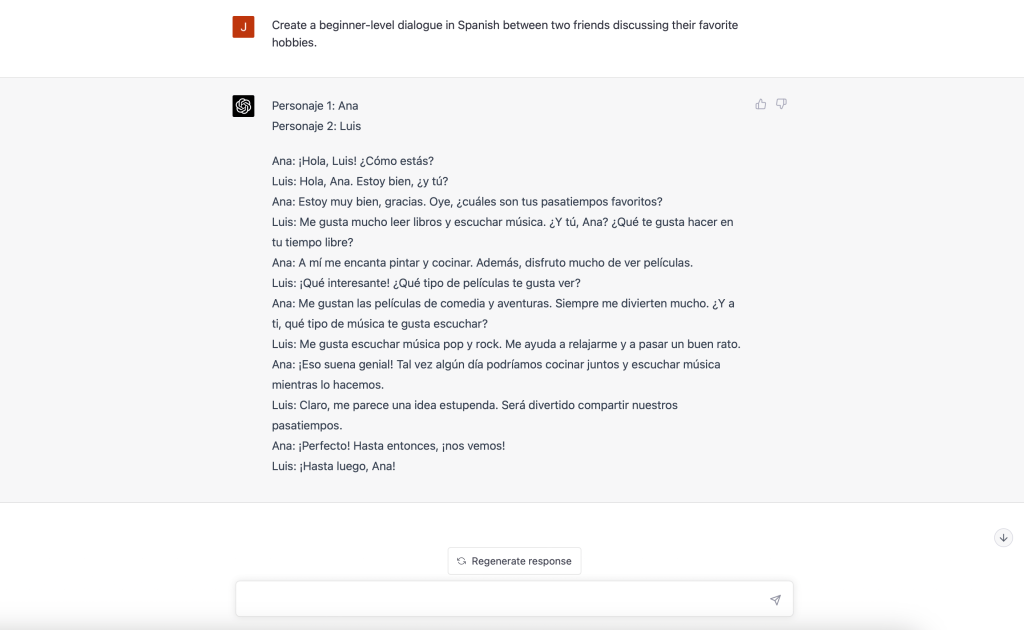We’re guessing that at some stage over the last few months you’ve heard about or seen reference to ChatGPT, the new phenomenon that’s taken the tech and education worlds by storm? If not, where have you been? And if yes, join the crowd!
In any case, this blog post aims to help our language education customers and blog readers to get up to date on the buzz around ChatGPT. We’ll start by looking at what it actually is and does; we’ll consider what value it could bring to language educators and schools; we’ll provide some thoughts on its future impact on language learning and teaching before closing off with practical examples on how you as a language teacher can start using ChatGPT today including a step-by-step guide on how to write an effective prompt for ChatGPT.
What is ChatGPT?
ChatGPT is a conversational bot that uses Artificial Intelligence (AI) to respond to users’ questions. It’s able to scan text and databases from across the internet to create text in a wide variety of forms. This depends on the specific prompt but can include essays, jokes, poetry and even language lesson plans.
The technology was made available to the public for free in November 2022. Since then it is estimated to have reached 100 million monthly active users in January, according to a recent survey from UBS. More specifically, an average of around 13 million unique visitors used ChatGPT per day in January. By comparison, it took Instagram 2.5 years to reach 100 million users.
ChatGPT is one example of generative AI. This term describes algorithms that can be used to easily and spontaneously create new content. In addition to text, other outputs include audio, code, images and videos. Evidently such breakthroughs have the potential to significantly disrupt many sectors including education and language learning.
As with other technological advances, some in education have responded with fear and concern. ChatGPT has, for example, already been banned by numerous universities and local governments, who fear it encourages cheating. But many educators (e.g. Professor Ethan Mollick at Wharton) are embracing ChatGPT and other AIs by embedding them into their courses and exploring their potential to transform learning.
Transforming language learning with AI
Experts suggest that the impact of generative AI technologies is likely to be focused on four main areas. We’ll cover those below and we’ll reference examples of language educators and companies who are already using the technology, even at this early stage.
1. Content creation
As outlined above, tools such as ChatGPT have been developed to produce content at scale and at great speed. Given that they respond to specific prompts, they can provide language educators and students with unlimited opportunities to create bespoke content.
This example from German teacher Klaudia Schwenk uses the image generating AI tool, Dall.E, to create specific images for a student worksheet. The examples she created provided a bespoke context so that her students could “practise forming sentences with verbs that take a dative and an accusative object.
Similarly @chrisjhingley used ChatGPT to create tailored lesson resources for her Spanish class. She wanted a “conversation with specific taught language + use of me gustaría + verb, based in a travel agency.” Although she was pleased with the results and time saved, she acknowledged that some editing and tailoring was needed before she could use the material with her students.
2. Personalisation
In addition to the highly tailored, specific content generation outlined above, generative AI also has the ability to transform how individual students learn languages.
Importantly generative AI tools are also highly capable of performing translation, so users can communicate with them in any language they choose. Polyglot, for example, enables learners to sharpen their language skills by text chatting with a language chatbot in Spanish, Chinese or English.
The app, Speak, takes this to the next level by enabling students to have a conversation in English “without needing a live tutor on the other end.” The AI also provides feedback to students and is able to replicate natural conversations. And because these technologies are constantly learning and improving, the quality of their responses will only get better over time.
3. Creativity
In addition to simply creating content, there’s increasing evidence that AI is driving a significant transformation of “traditional” creative industries. A new wave of AI tools will make it quicker, easier and cheaper for anyone to create apps, podcasts and videos.
This will have significant implications for language course producers and institutions. Tools such as Edugo.AI, for example, already enable anyone to create “personalised and gamified language courses with the power of AI.” The platform is already being used globally by individual teachers and institutions to build courses and now has nearly 50k international users.
4. Reducing workload
Many educators across different subjects have immediately identified that ChatGPT (and other AI tools) can be powerfully used to reduce their workload. In particular around the time-consuming and often monotonous work of lesson planning. This Geography example from Stephen Lockyer powerfully demonstrates what the technology can do. Although as he’s also quick to point out: ”I’m not saying this is perfect in any way! I’d certainly not teach like this but as a baseline it’s fascinating.”
Advocates for such AI-powered tools reiterate that they are a tool to supplement and support existing practice, rather than seeking to completely replace it. In doing so, such solutions can free up time for teachers to do the things that really matter and which technology cannot do – engaging with students face to face and supporting their learning / personal development.
Friend or foe?
A recent Brookings Institution report considered this argument at length. Despite legitimate concerns from educators and schools that tools such as ChatGPT would lead to the death of writing and wholescale cheating, the report concluded that: “Used in the right way, ChatGPT can be a friend to the classroom and an amazing tool for our students, not something to be feared.”
Similarly, as EdTech VC, Tony Wan argues: “Others have framed the debate as an existential battle between two AIs: artificial intelligence versus academic integrity. But it doesn’t need to be so combative and oppositional. More likely, they’ll evolve together as kids, teachers and technologists uncover new ways to teach, learn, think and build with AI.”
At Sanako we already make appropriate use of advanced technology in our digital products and are currently exploring how we can adapt to the opportunities offered by generative AI tools. Those developments acknowledge Stephen Lockyer’s position that “..it (ChatGPT) has no nuance or flair which the individual teacher brings.” We also want to help students and teachers to change the conversation around generative AI from “look what the technology did” to “look what I did with the technology.”
But perhaps most importantly, we share Geoff Barton’s view that the technology will “liberate teachers to teach.” And that should be something everyone in language education can get behind!
So, how can ChatGPT help language educators in practice?
As a language educator, finding engaging and practical activities for your students can be a challenging task. However, with the help of ChatGPT, you can easily create a variety of language learning activities that will keep your language learners motivated and excited to practice. We will explore 5 practical language learning activities that you can ask ChatGPT to create for your language learners straight away! As a language educator, you just need to design accurate and clearly understandable prompts that guide ChatGPT to create the activities you are looking for. The below examples are for Spanish learning but you can easily modify the prompts to target any language.
1. Dialogue Creation for Speaking Practice
Ask ChatGPT to create a dialogue between two or more characters, focusing on a specific topic or situation that you think is engaging and interesting for your students. This could be a conversation between friends discussing their favourite football teams, a dialogue between a customer and a video games shopkeeper, or a conversation between a doctor and a patient. You can tailor the dialogue to the skill level of your students, and use the dialogue directly for speaking practice and role-playing activities. After you have created the initial scene/dialogue it is very easy to expand further by asking ChatGPT to create additional tasks such as gap-fill, multiple choice or vocabulary activities that are all based on this imaginary dialogue. You also have the option to ask ChatGPT to create intermediate or even advanced version of the same dialogue to cater for different students or student groups.
Example prompt for ChatGPT: “Create a beginner-level dialogue in Spanish between two friends discussing their favourite Spanish La Liga football clubs.”
2. Grammar Exercises
Ask ChatGPT to create grammar exercises that target specific grammar points, such as verb conjugations, adjective agreement, or the use of pronouns. You can request activities like fill-in-the-blank exercises, sentence transformation tasks, or error correction activities.
Example prompt for ChatGPT: “Create a fill-in-the-blank exercise based on the above Spanish dialogue and focusing on the conjugation of regular -ar verbs in the present tense.”
3. Vocabulary Building Activities
Request ChatGPT to create vocabulary-building activities to help your students expand their Spanish lexicon. This could include creating vocabulary lists with definitions and example sentences, crossword puzzles, word searches, or matching activities.
Example prompt for ChatGPT: “Create a list of 15 common Spanish verbs related to travel, along with their definitions and example sentences.”
4. Reading Comprehension Exercises
Ask ChatGPT to create short texts or stories in Spanish, along with comprehension questions to test your students’ reading skills. You can request texts of varying difficulty levels and themes, depending on the needs of your students.
Example prompt for ChatGPT: “Create a short story in Spanish for intermediate learners about a family vacation, along with five reading comprehension questions.”
5. Cultural Activities
Language learning is not just about grammar and vocabulary; it’s also about understanding the culture of the people who speak the language. Ask ChatGPT to create activities that help your students learn more about Spanish-speaking cultures, such as researching famous Spanish-speaking people, exploring cultural traditions, or discussing current events in Spanish-speaking countries.
Example prompt for ChatGPT: “Create a list of five famous Spanish-speaking artists and a brief description in Spanish of their work, along with discussion questions for my students.”
Conclusion – Write specific prompts
With ChatGPT, creating engaging and practical language learning activities for your language learners has never been easier. It is a real time saver for any teacher who is looking to create engaging and fun language learning activities and content for their students. The great thing is that now you have a fast and easy way to tailor your content and activities based on your students level and interest areas instead of having to use just generic and potentially uninteresting materials.
This is an example prompt asking ChatGPT to create a beginner-level dialogue in Spanish that can then be used as the source content for different language learning activities.
To get the most out of ChatGPT and ensure you receive useful and accurate responses, it’s essential to write clear, concise, and specific prompts. Below are some guidelines to help you write effective prompts that help you create the language learning resources you want. These guidelines are actually given by ChatGPT itself when we asked it to explain “the best and most effective way to write prompts for ChatGPT”. We really think he/she/it is the best person/thing to explain this! 🙂
-
Be specific: Clearly define your request and provide enough context or details to help ChatGPT understand what you’re looking for. If you need information about a particular subject, time period, or context, be sure to include those details in your prompt.
-
Set a format: If you’re looking for a specific format for the response, such as a list, a table with two columns, an imaginary dialogue or story, a step-by-step guide, or a brief summary, mention that explicitly in your prompt. This helps ChatGPT tailor its response according to your needs.
-
Ask direct questions: If you’re seeking an answer to a question, make sure to phrase it as a direct question. This will help guide ChatGPT to provide the information you’re looking for.
-
Provide examples: Including examples in your prompt can help ChatGPT understand the type of response you’re looking for. For instance, if you’re requesting a language learning activity, you could provide an example of the type of activity you’d like to see.
-
Break down complex requests: If you have a multi-part or complex request, break it down into smaller, more manageable tasks. You can submit these tasks one at a time or as a numbered list to ensure ChatGPT addresses each part of your request.
-
Be mindful of the model’s limitations: Remember that ChatGPT is an AI language model with a knowledge cutoff of September 2021. It might not be aware of events or developments that have occurred since then. Additionally, it might not always provide accurate or up-to-date information. For critical or time-sensitive topics, be sure to cross-check the information provided by ChatGPT with other reliable sources.
By following these guidelines, you’ll be able to craft effective prompts that elicit useful and relevant responses from ChatGPT, making your AI-boosted language learning activities and content more productive and effective!
Are you interested to learn more how Sanako’s language teaching technology could transform language teaching in your school or university? Contact us now to book your free remote demo!
This blog post was last updated 28 March, 2023.


